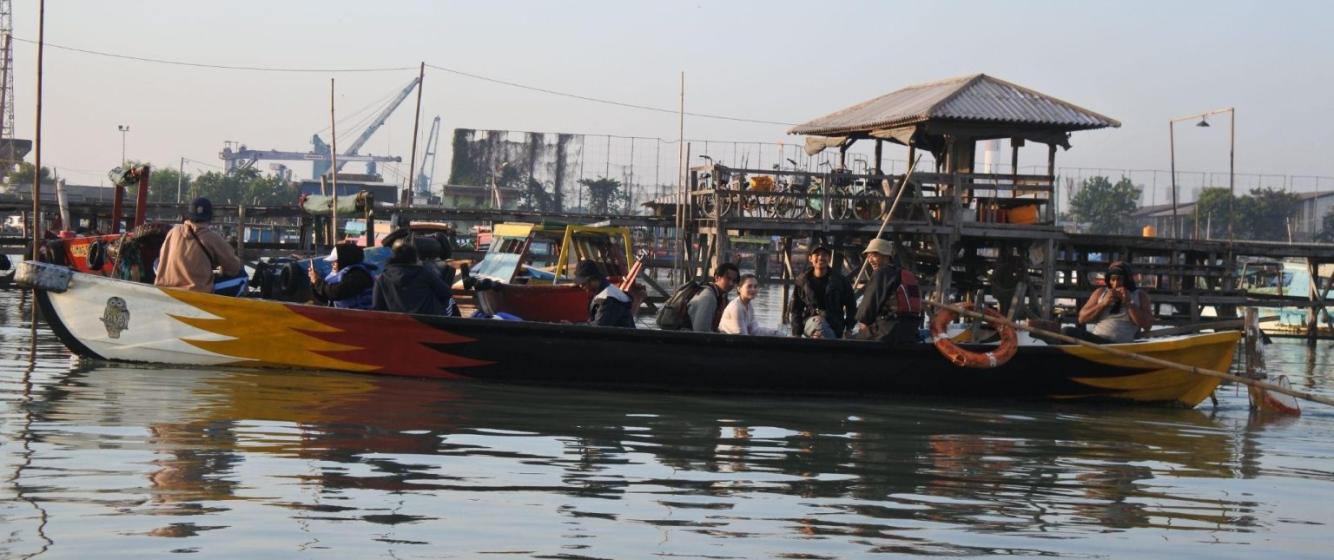
Ritus Liyan participants on a fishing boat in Kampung Lumpur, Gresik, Indonesia.
Credit: AIIOC, Indonesia (2025)
Ritus Liyan (Mundane Rites) 2: Mentorship as Curation
From 28 April to 2 May, the Airlangga Institute for Indian Ocean Crossroads (AIIOC) hosted its second edition of Ritus Liyan (The Mundane Rites) workshop and artistic exhibition held in the Kampung Lumpur coastal village of Gresik, Indonesia. Titled Superposi Pesisir or “Coastal Superposition”, the five-day workshop-cum-exhibition invited eight artists, researchers, and cultural activists to dialogue, reflect, and create artistic representations in residence alongside locals on everyday coastal rituals and practices.
In this excerpt from the Superposi Pesisir exhibition catalogue, AIIOC and Indonesian artist and workshop facilitator Pingki Ayako reflect on how the role of curator differs in Ritus Liyan from conventional art practices and the importance of mewarga or horizontal engagement between the community and the artists in the Ritus Liyan workshops.
Constructing Reality in Interpersonal Relations
In Ritus Liyan, art is understood as a form of aestheticisation that emerges from a dialogical process and compromise between the daily rituals and local wisdom of the Lumpur community and the artistic perceptions of the participants—namely, the artists. The diverse backgrounds of the participants' artistic practices, as well as the sensitivity required to explore and articulate the hidden meanings within the residents' daily practices, differentiate the process of knowledge transfer and curation of works in Ritus Liyan from conventional art creation.
In conventional art practices, the curator's role tends to be central and dominant, often acting as the sole party enriching the artist's work. The dialogue process is usually limited to the relationship between the curator and the artist, encompassing discussions about theoretical references, the medium of the work, presentation strategies, and possible audience interpretations. In contrast, in Ritus Liyan, there is an additional, fundamental factor in determining the final form of the work: community involvement. The local community is not merely an object of observation but also plays an active role as a subject influencing the artistic and conceptual direction of the work.
The choice of Kampung Lumpur as a site for the second Ritus Liyan is inspired by the kampung’s contemporary condition as a coastal site that has been industrialised. The community members work as fishermen, transport vessel operators, fish sellers, seafood vendors, and other marine-based entrepreneurs. Aside from such livelihood, other members also work in the oil and natural gas resources industries that are abundant in Gresik, not only in Kampung Lumpur. The presence of these industries affects the political economy and the ecology of Kampung Lumpur. Within such a backdrop, Ritus Liyan attempts to respond and to cultivate a novel knowledge production and dissemination that are sensitive to Kampung Lumpur’s socio-cultural and economic conditions.
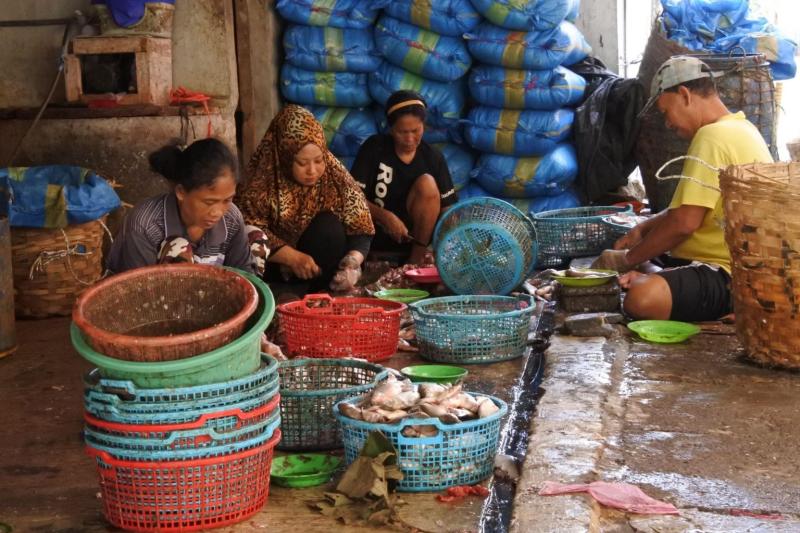
AIIOC, Gresik, Indonesia (2025)
Residents of Kampung Lumpur cutting and processing fish and other seafood.
The term "citizens" as "an additional factor" in the “mundane rites” actually represents an infinite number of factors. Citizen involvement reflects a diversity of characters, forms of knowledge, and levels of participation that are highly contextual and particular, in line with Ritus Liyan's focus on exploring the subtleties of everyday rituals. A salted fish processor certainly has different life experiences and knowledge from a fisherman, and both offer unique insights to the participants involved.
Citizen participation is also dynamic and cannot be predicted empirically, both in terms of quantity and depth of involvement. Therefore, the mentoring process in the Ritus Liyan demands an adaptive and responsive approach to local conditions. In this context, the term mewarga is considered more appropriate than membumi, as it emphasises horizontal engagement between artists and citizens.
The fluidity of Ritus Liyan's methodology produces wide-ranging objects that were exhibited and are of use for Kampung Lumpur villagers. Each participant’s produce was influenced by the diverse backgrounds that each participant had. A perfume possessing the scent of coastal olfaction and a musical piece inspired by and representing Kampung Lumpur’s vibrant soundscape are two examples of what collegial citizen participation has produced. Aside from these two, material art forms such as posters, murals, and paintings were exhibited. Both the workshop and the exhibition are held collaboratively by, in, and especially for the local community in Kampung Lumpur.
Ritus Liyan 2: Coastal Superposition Coordination Scheme
-
Co-Organising
The AIIOC and the 11th East Java Biennale are the two main institutions acting as organisers and central managers of the Ritus Liyan 2: Coastal Superposition program. These two institutions play a strategic role in formulating the program's vision, setting goals, and coordinating resources and operational policies.
In the program's implementation, five mentors—including Bintang Putra, Pingki Ayako, Gata G. Mahardika, Ragil C. Maulana, and Ismal Muntaha—were selected based on their competence and experience in research, art, and curatorial fields. These mentors serve as mediators who articulate the organising institutions' strategic vision into the practical implementation of the program, encompassing everything from the research phase to the curation process in artistic production for Ritus Liyan participants.
-
Mentoring & Curating
Five mentors—Bintang Putra, Pingki Ayako, Gata G. Mahardika, Ragil C. Maulana, and Ismal Muntaha—with multidisciplinary backgrounds played a role in developing the concept and procedures for the Ritus Liyan program. The mentors also served as the initial bridge connecting the participants with the community in Kampung Lumpur Gresik. As the field research progressed, the mentors' role shifted to the curatorial realm.
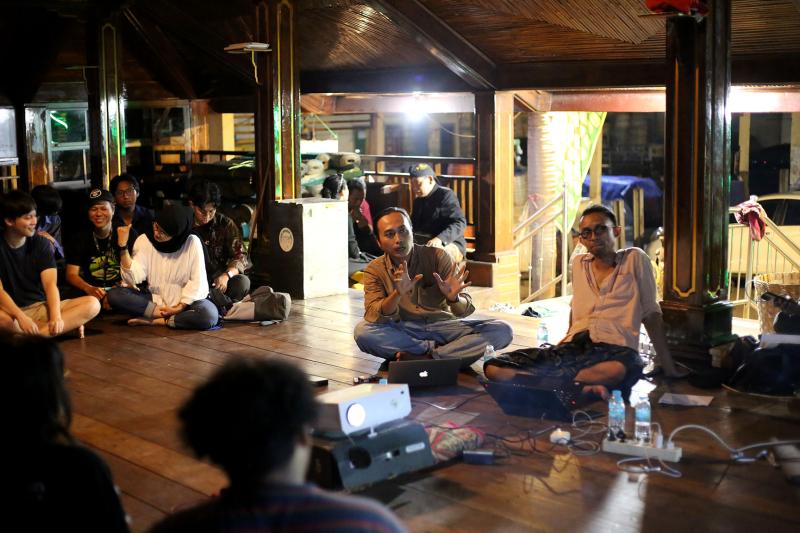
AIIOC, Gresik, Indonesia (2025)
Ritus Liyan mentors in conversation with the artists and village residents on the first day of the workshop.
At this stage, the curators actively engaged in discussions to strengthen the foundation of the creative concept, facilitate productive and inclusive collaboration between participants and residents, and guide the creative process to avoid practices that diminish or exploit local resources. From this, the curators provided recommendations for artistic approaches relevant to the context of the location and the characteristics of the audience in Kampung Lumpur Gresik.
-
Co-Curating
Several individuals from the residents of Lumpur Gresik, who intensively served as resource persons representing their communities, had the potential to become intermediary curators, or "Co-Curators." As Co-Curators, they can articulate and interpret cultural practices, daily rituals, and local values inherent in the daily lives of residents. This role involves conceptual mediation that bridges local understanding with curatorial narratives to open up creative perspectives for Ritus Liyan participants, thus enabling the articulation of authentic and contextual artistic media. Thus, "citizen" Co-Curators act as dialectical agents, connecting local knowledge with the curatorial framework in contextual, reflective, and participatory artistic development.
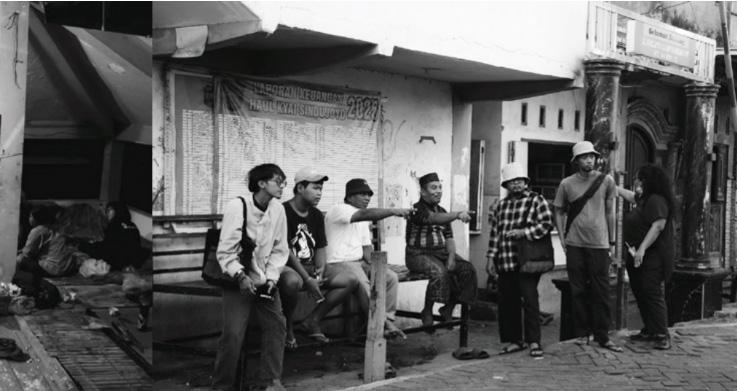
AIIOC, Gresik, Indonesia (2025)
Participants sitting and conversing with resident Co-Curators.
-
Mentoring & Curating "Citizens"
Citizen knowledge serves not merely as factual information, but also provides an authentic foundation and cultural context that enriches and deepens the meaning of the artworks produced by Ritus Liyan participants. Therefore, residents deserve to be positioned as Mentors, or more specifically, as Curators, due to their capacity as holders of irreplaceable local knowledge—whether in the form of lived experiences, daily rituals, or the collective values that shape community identity. In this position, residents influence the direction of exploration, provide feedback on ideas, and contribute to shaping social and ethical sensitivity in the artistic enrichment process.
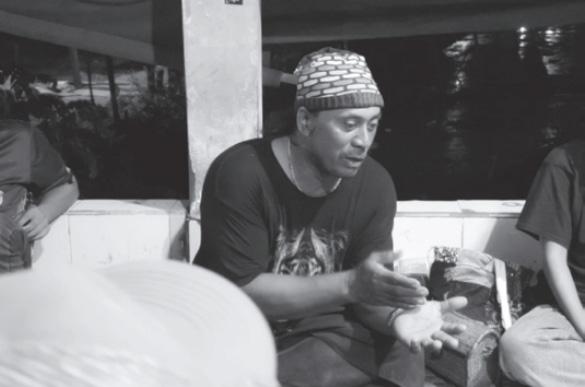
AIIOC, Gresik, Indonesia (2025)
Barok, a local fisherman, speaking to the artists.
Conclusion
Through equal and dialogical relationships, the artistic process of Ritus Liyan emphasises the importance of resident involvement as active subjects in the production of knowledge and aestheticisation, which "originates from" and "returns to the community itself."
If the process of exploring residents' daily rituals is analogous to a "treasure hunt," then the residents are "holders of the key and secret map" guiding the discovery of the treasure.
Add new comment